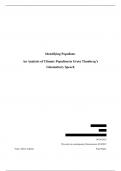(TAPEWORMS)
We are focussing on eucestoda, a subclass of cestode characterized by its segmentation, present in man and
animals. The cestodes are also multicellular parasites that can be larger in size than the trematodes. Typical for
tapeworms is that they are segmented Platyhelminthes. All tapeworms as adults can be found in the intestine,
but at a certain point some cestodes can also be present extra-intestinal, this is the case when the human acts
as an intermediate host (parasite in larval stage in the human host).
GENERAL CHARACTERISTICS
o Parasitic in vertebrates
o Global distribution
o As adult: always in the gastrointestinal system (small intestine)
o At least 2 different hosts: indirect, heteroxene cycle
o Characteristics first stage larva: hexacanth (3x2 hooks)
o No free-living stages, all stages are endoparasites
o Host specificity: (<-> trematodes)
High specificity for vertebrate final host
Low specificity for intermediate hosts
o Variable size: few mm to several meters
Morphology
o Dorso-ventrally flattened
o Segmented (<-> trematodes): each segment has similar organisation as trematodes
Coelome and intestinal system is absent: no pharynx and caeca
Excretion system based on flame cells and protonephridia: excretion of electrolytes +
osmoregulation
Hermaphrodite: male and female reproductive organs repeating per segment
Rule is self-fertilization (<-> trematodes: cross-fertilization)
o Scolex – neck – storbila (proglottids)
Scolex: head of the parasite
Strobila: part where you start having the different segments being formed
Segments = proglottids
General structure:
o Scolex – neck – strobulae
Scolex: different possibilities according to species (identification)
Bothriate: kind of 2-membranous fold with cavity, enables attachment
Rostellum: anterior part of parasite has hooks and suckers (actebula)
o Oral and ventral suckers important for motility and attachment
o Hooks can cause tissue damage
Armed scolex: hooks
o Ladder-type neurological system + scolex has neuronal ganglion that controls the muscular
movements of the suckers of the rostellum
Organs and structures:
, o Tegument: cytoplasmic syncytium
Constantly proliferating and renewing: fast turnover
Important for nutrient uptake
Lot of microvilli (<-> trematodes): increase of surface with factor of 20, important for
uptake of nutrients through the tegument
Microtrichen on top of villi: small spines
Nutrient uptake through tegument: glucose, amino-acids
o Nervous system: ladder-type with ganglion in scolex
innervation of muscle for attachment
important for strobilation process: process of making the different proglottids
immature proglottids
mature proglottids: both male and female reproductive organs (hermaphrodit)
o first male organs are produced
o later female organs are produced
gravid proglottids: after fertilization, contain in the uterus the presence of eggs
o no digestive system: no pharynx, no caeca
uptake of nutrients (glycose and AA) through tegument
can store glucose in form of glycogen
o excretion of electrolytes: based on protonephridia and flame cells
excretion ducts: transversal + longitudinal, removal of ammonia
high capacity to re-absorb glucose, low excretion of glucose can be fully used for
metabolism
o reproduction: hermaphrodites
mostly self-fertilization, in some cases when people are infected with multiple tape-worms
cross-fertilization is also a possibility
but protandry: first development of male reproductive organs, afterwards female
2 major types of tape worms:
Pseudophilidae: continuous excretion of eggs
Cyclophilidae: eggs generally in proglottide, they will just release the proglottid
Proglottid structure:
The proglottid structure is species-specific and thus can be used for the identification of different cestode
species.
2 different strategies:
o Apolytic: remove or excrete entire proglottid where the eggs are stored in the uterus and as such
also are protected from the environment
, o Anapolytic: eggs from the uterus are excreted through the genital pore, the eggs have an egg shell
which protects the eggs better in the environment
Comparative morphology
o Diphylolobothrium
Scolex: bothriate
Eggs: dark egg shell + operculum
o Taenia: pork and beef tapeworm
Scolex: armed rostellum, has hooks and suckers (acetubula) important for attachment
Taenia saginata: hooks absent
Taenia solium: hooks present
Eggs: no egg shell (apolytic) but thick multi-layered wall of the egg (embryophore) and inner
envelope
o Dipylidium
Scolex: rostellum with very small hooks, other line-up of the hooks
Proglottids:
2 female and 2 male reproductive organs: clearly see 2 genital pores on both sides
Gravid proglottids: eggs stored in egg packages in the uterus
Eggs: egg shell + thick embryophore and inner envelope
Most of time: eggs are excreted as egg packages
Conclusion: based on the morphology of the scolex, the proglottids and the eggs, differential diagnosis is
possible.
GENERAL CLASSIFICATION OF EUCESTODA
The Eucestoda consists of 2 different orders, Pseudophilidea and Cyclophilidea, that differ in the life stages in
the intermediate host.
o Pseudophilidea: adaptations that enable them for life cycle in water environment
Diphyllobothrium latum
Spirometra: extra-intestinal parasites (larval stages), normally not pathogen of humans but
cats/dogs (fish-eating carnivores)
o Cyclophilidea: life cycle typical on land, bladder-type of intermediate stages
Dipylidium caninum: infection through flees of dogs
Hymenolepis nana/diminuta: infection through eating contaminated cereals
Taenia solum/saginata: beef and pork tapeworm
Echinococcus granulosus/multilocularis: fox tapeworm










